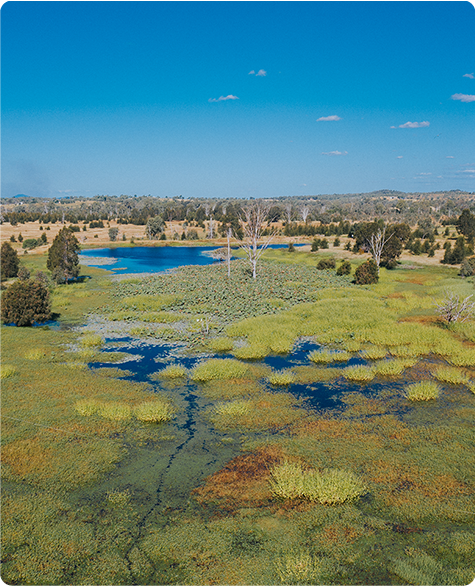1. Australian red meat isn't the global villian you think it is
Cows, sheep and other ruminant animals are often linked to global warming because of the methane they emit during their natural digestive process (i.e. when they burp). Methane is a strong greenhouse gas (GHG) that is recognised as a contributor to global warming. But when it comes to the red meat industry, the climate change link is not as clear cut. The Australian red meat industry has made significant progress to reduce these emissions and is committed to contributing to Australia's net zero ambitions.
2. Livestock farming uses non-arable land productively
Almmost 75% of Australia's land is classed as rangelands where rainfall is too low or unpredictable. These rangelands are not well suited for crops but optimal for grazing livestock.
Because of Australia’s unique geological, topographic and climatic factors, only 3.75% of Australia’s land mass is used for crop production. Australian cattle, sheep and goats survive and thrive in these landscapes by converting pasture and shrubs into food.
The unique digestive systems of cows, sheep and goats allow them to eat plants that cannot be eaten by humans – converting this low nutrient plant into high-quality protein, fatty acids, vitamins and minerals that we can enjoy as part of a balanced diet.
In addition, well-managed grazing of pastures by livestock can stimulate soil microbial activity and plant growth, which can increase the draw down of CO2 via photosynthesis.
3. Net greenhouse gas emissions from red meat are falling
In 2022-23, the major sources of national emissions (excl Land Use, Land-Use Change and Forestry (LULUCF)) were stationary energy (47.9%), transport (18.3%), and agriculture (15.6%). Enteric methane, largely from sheep, dairy and beef cattle, contributes around 71% of agriculture’s footprint. If the red meat industry was its own category, in 2022-23, the industry contributed approximately 10% of national greenhouse gas emissions (incl LULUCF).*
On top of this, GHG emissions from agriculture are falling. As at 2023, net GHG emissions from the Australian red meat industry had fallen by 70.2% since 2005*
4. Red meat has less impact on water scarcity than other foods
Since Australian cattle and sheep typically graze on native grasses, bushes and improved pastures, red meat production relies mostly on rainfall for water, so there’s not much competition for water. In reality, red meat consumption contributes only 3.7% of the total dietary water-scarcity footprint (the potential impact associated with the quantity of water consumption). Based on this data, consuming red meat is less impactful to water scarcity than most other food groups, even cereals.
5. Red meat is committed to contributing to Australia's net zero ambitions
The industry remains fully committed to methane reduction, carbon sequestration, driving emissions intensity reduction and contributing to Australia’s net zero ambitions while advancing profitability, productivity and sustainability.
The Australian red meat industry is exploring ways to reduce net emissions through:
- Pastures, shrubs and legumes that improve livestock productivity and lower methane emissions
- Animal genetics and husbandry practices to increase efficiency and reduce methane emissions intensity
- Equipment to capture and reuse methane from processing waste treatment
- Energy efficiency and renewable energy technology to reduce CO2 emissions from the use of fossil fuels
- Equipment to reduce nitrous oxide (N2O) and methane emissions from manure lot feeding
- Savanna burning management methods to avoid dangerous hot fires which produce emissions of N2O and methane.
The Australian red meat industry cares about its impact on the environment. Reducing net GHG emissions and optimising land and water usage are major goals for everyone involved. So, enjoy red meat as part of a balanced diet, and know that it’s doing a world of good.
* Data analysed from the National Inventory Report 2023, Volume 1 (dcceew.gov.au) and 2023 Greenhouse gas emissions footprint of red meat (mla.com.au)





